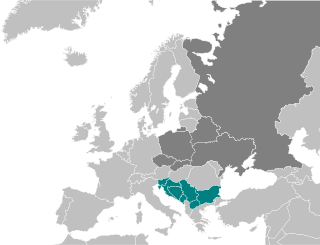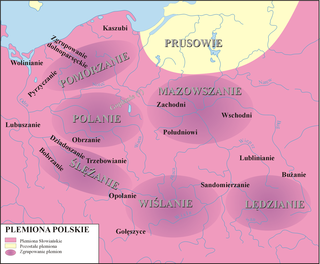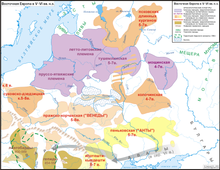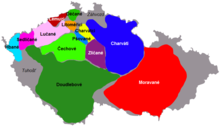The Slavs or Slavic people are groups of people who speak Slavic languages. Slavs are geographically distributed throughout the northern parts of Eurasia; they predominantly inhabit Central Europe, Eastern Europe, and Southeastern Europe, though there is a large Slavic minority scattered across the Baltic states, Northern Asia, and Central Asia, and a substantial Slavic diaspora in the Americas, Western Europe, and Northern Europe.

The East Slavs are the most populous subgroup of the Slavs. They speak the East Slavic languages, and formed the majority of the population of the medieval state Kievan Rus', which they claim as their cultural ancestor. Today Belarusians, Russians and Ukrainians are the existent East Slavic nations. Rusyns can also be considered as a separate nation, although they are often considered a subgroup of the Ukrainian people.

The Severians, also Severyans, Siverians, or Siverianians were a tribe or tribal confederation of early East Slavs occupying areas to the east of the middle Dnieper River and southeast of the Danube River. They are mentioned by the Bavarian Geographer, Emperor Constantine VII (956–959), the Khazar ruler Joseph, and in the Primary Chronicle (1113).
The Vistula Veneti, also called Baltic Veneti or Venedi, were an Indo-European people that inhabited the lands of central Europe east of the Vistula River and the Bay of Gdańsk. Ancient Roman geographers first mentioned Venedi in the 1st century AD, differentiating a group of peoples whose manner and language differed from those of the neighbouring Germanic and Sarmatian tribes. In the 6th century AD, Byzantine historians described the Veneti as the ancestors of the Slavs who - during the second phase of the Migration Period - crossed the northern frontiers of the Byzantine Empire.

The Uliches or Ugliches were a tribe of Early East Slavs who, between the eighth and the tenth centuries, inhabited Bessarabia, and the territories along the Lower Dnieper, Bug River and the Black Sea littoral.

The Tivertsi, were a tribe of early East Slavs which lived in the lands near the Dniester, and probably the lower Danube, that is in modern-day western Ukraine and the Republic of Moldova and possibly in eastern Romania and the southern Odesa oblast of Ukraine. The Tivertsi were one of the tribes that formed the Ukrainian ethnicity, namely the sub-ethnic and historic region of Podolia. The Tivertsis' cultural inheritors, the Podolians, are a distinct group of Ukrainians.
The Buzhans were one of the tribal unions of Early Slavs, which supposedly formed East Slavs in Southern Russia and Volga region. They are mentioned as Buzhane in the Primary Chronicle. Several localities in Russia are claimed to be connected to the Buzhans, like for example Sredniy Buzhan in the Orenburg Oblast, Buzan and the Buzan river in the Astrakhan Oblast.

The Vistulans, or Vistulanians, were an early medieval Lechitic tribe inhabiting the western part of modern Lesser Poland.

The White Croats, also known simply as Croats, were a group of Early Slavic tribes that lived between East Slavic and West Slavic tribes in the historical region of Galicia north of the Carpathian Mountains, and possibly in Northeastern Bohemia.

South Slavs are Slavic people who speak South Slavic languages and inhabit a contiguous region of Southeast Europe comprising the eastern Alps and the Balkan Peninsula. Geographically separated from the West Slavs and East Slavs by Austria, Hungary, Romania, and the Black Sea, the South Slavs today include Bosniaks, Bulgarians, Croats, Macedonians, Montenegrins, Serbs and Slovenes.

The West Slavs are Slavic peoples who speak the West Slavic languages. They separated from the common Slavic group around the 7th century, and established independent polities in Central Europe by the 8th to 9th centuries. The West Slavic languages diversified into their historically attested forms over the 10th to 14th centuries.

The Lendians were a Lechitic tribe who lived in the area of East Lesser Poland and Cherven Cities between the 7th and 11th centuries. Since they were documented primarily by foreign authors whose knowledge of Central and East Europe geography was often vague, they were recorded by different names, which include Lendzanenoi, Lendzaninoi, Lz’njn, Lachy, Lyakhs, Landzaneh, Lendizi, Licicaviki and Litziki.
Lechites, also known as the Lechitic tribes, is a name given to certain West Slavic tribes who inhabited modern-day Poland and eastern Germany, and were speakers of the Lechitic languages. Distinct from the Czech–Slovak subgroup, they are the closest ancestors of ethnic Poles and of Pomeranians, Lusatians and Polabians.

The most important phenomenon that took place within the lands of Poland in the Early Middle Ages, as well as other parts of Central Europe was the arrival and permanent settlement of the West Slavic or Lechitic peoples. The Slavic migrations to the area of contemporary Poland started in the second half of the 5th century AD, about a half century after these territories were vacated by Germanic tribes fleeing from the Huns. The first waves of the incoming Slavs settled the vicinity of the upper Vistula River and elsewhere in the lands of present southeastern Poland and southern Masovia. Coming from the east, from the upper and middle regions of the Dnieper River, the immigrants would have had come primarily from the western branch of the early Slavs known as Sclaveni, and since their arrival are classified as West Slavs and Lechites, who are the closest ancestors of Poles.[a]

The Antes or Antae were an early Slavic tribal polity of the 6th century CE. They lived on the lower Danube River, in the northwestern Black Sea region, and in the regions around the Don River. Scholars commonly associate the Antes with the archaeological Penkovka culture.

The early Slavs were Indo-European peoples who lived during the Migration Period and the Early Middle Ages in Central, Eastern and Southeast Europe and established the foundations for the Slavic nations through the Slavic states of the Early and High Middle Ages. The Slavs' original homeland is still a matter of debate due to a lack of historical records; however, scholars believe that it was in Eastern Europe, with Polesia being the most commonly accepted location.
The Zeriuani or Zeruiani was an unknown Slavic tribe mentioned by the 9th-century Bavarian Geographer (BG). It states that the Zeruiani "which is so great a realm that from it, as their tradition relates, all the tribes of the Slavs are sprung and trace their origin". It was the first Latin source to claim that all Slavs have originated from the same homeland.
Sporoi or Spori was according to Eastern Roman scholar Procopius (500–560) the old name of the Antes and Sclaveni, two Early Slavic branches. Procopius stated that the Sclaveni and Antes spoke the same language, but he did not trace their common origin back to the Veneti but to a people he called "Sporoi". He derived the name from Greek σπείρω, because "they populated the land with scattered settlements".
The Slavic ethnonym, Slavs, is reconstructed in Proto-Slavic as *Slověninъ, plural Slověně. The earliest written references to the Slav ethnonym are in other languages.
Topical outline of articles about Slavic history and culture. This outline is an overview of Slavic topics; for outlines related to specific Slavic groups and topics, see the links in the Other Slavic outlines section below.


















